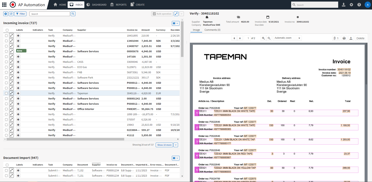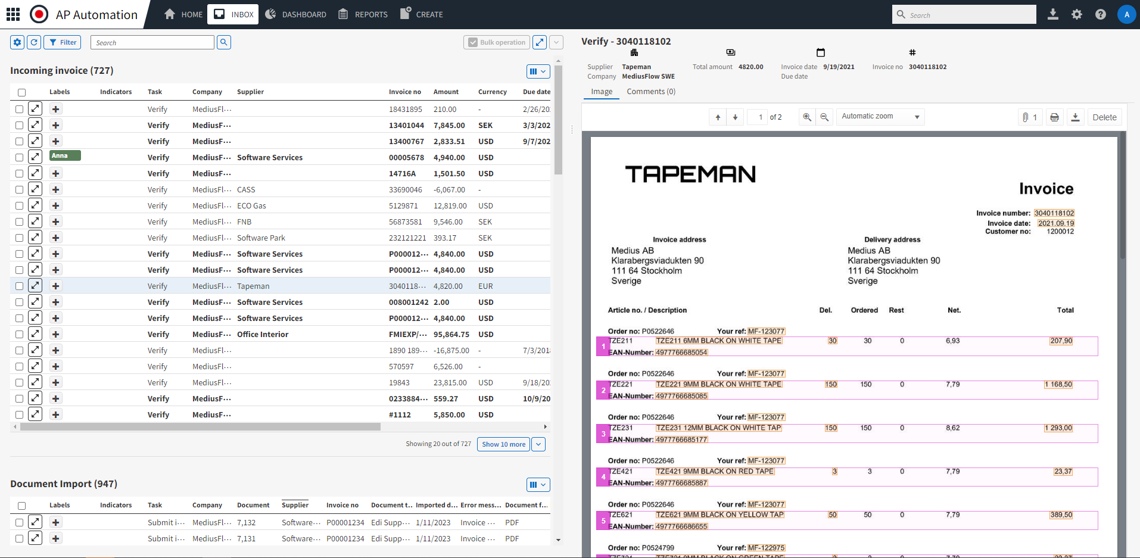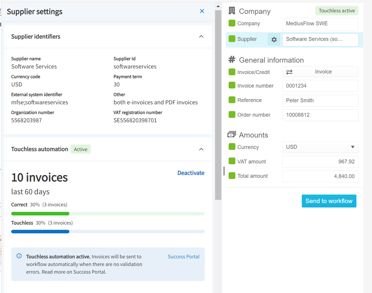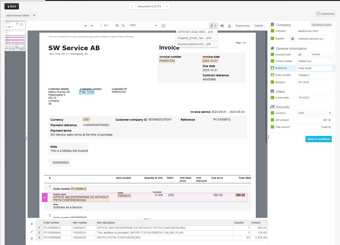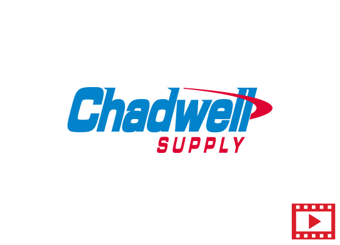

What is invoice scanning?
Invoice scanning is the process of converting physical supplier invoices into digital format, typically using scanning hardware combined with optical character recognition (OCR) software. OCR identifies printed characters on scanned documents and converts them into machine-readable text.
"Invoice scanning" usually refers to handling paper invoices, but today many accounts payable (AP) teams also work with digital formats like PDFs or e‑invoices. In these cases, the goal is less about scanning and more about extracting usable invoice data for processing.
What is invoice data capture?
Invoice data capture extracts key details like supplier name, invoice number, date, line items, and amounts from invoices in different formats (paper, PDF, XML, EDI) and organizes them into a digital system. Unlike basic scanning that just creates a digital copy, data capture converts invoice information into usable data that can be validated, matched, coded, and sent for approval.

The role of AI in invoice capture
Modern invoice data capture tools, like Medius Capture, use artificial intelligence (AI) and machine learning (ML) to improve accuracy and reduce manual work. These systems can learn from past invoices, adjust to new formats, and process various layouts without needing templates.
Key capabilities of AI-based invoice capture:
- Automatically extracts data from various formats, including paper, PDF, XML, and EDI
- Recognizes invoice fields regardless of layout or vendor
- Learns from historical data to improve accuracy over time
- Flags missing or inconsistent information
- Reduces the need for manual validation or template configuration
Template-based capture vs. AI-based capture
Traditional invoice capture tools often rely on template-based recognition, using pre-set rules to identify data fields. This means they usually need manual setup for each vendor or invoice format.
In contrast, AI-based systems use machine learning to extract data without relying on templates. This makes them more flexible and scalable, especially for organizations handling invoices from hundreds or thousands of suppliers.
| Feature | Template-Based Capture | AI-Based Capture |
|---|---|---|
| Layout flexibility | Limited – format-dependent | Highly adaptable to new formats |
| Setup and maintenance | Requires manual configuration | Learns from patterns automatically |
| Accuracy over time | Static | Improves with use |
| Exception handling | Often manual | Can suggest resolutions automatically |
| Scalability | Requires effort as volume grows | Easily handles increasing volumes |
How invoice capture fits into AP automation
Invoice capture is typically the first step in an automated accounts payable process. Once invoice data is extracted, it can be validated, matched to purchase orders, coded to the correct accounts, and routed for approval.
High-quality data capture improves downstream automation. For example:
- Reducing errors during PO matching
- Speeding up approvals
- Supporting touchless processing (invoices that require no manual touch from receipt to payment)
- Providing better visibility into invoice status and payment timing
Example: AI-powered invoice capture in action
An AI-based AP solution may extract data from a supplier invoice and automatically:
Identify the supplier from vendor ID or name
Recommend the appropriate general ledger (GL)
code based on past patterns
Suggest the correct approver from historical approvals
Flag inconsistencies or discrepancies compared to previous invoices
When is physical scanning still used?
While electronic invoices are becoming more common, some industries and regions still use paper invoices. In these cases, physical scanners digitize the documents so AI/OCR tools can extract the data. Businesses can either scan the documents in-house or outsource the task, only working with the digital files afterward.
Benefits of modern invoice capture tools
Time savings
Automates data entry and minimizes manual intervention
Accuracy
Reduces errors in data capture and invoice matching
Compliance
Ensures a clear audit trail and consistent processing
Scalability
Supports high volumes of invoices without requiring more staff
ERP integration
Sends validated data directly into systems like SAP, Oracle, NetSuite, and Microsoft Dynamics
Is invoice scanning the same as invoice automation?
No. Scanning and digitizing an invoice is just one step in the larger AP automation process. True automation requires capturing usable data, validating it, and routing it through workflows without manual effort.
Digitized invoices that still require manual processing (such as coding, matching, or approvals) are not fully automated.
FAQs on invoice scanning
Paper invoices, scanned documents, PDFs, electronic invoices (e-invoices), and EDI invoices.
Most solutions integrate smoothly with ERP and accounting platforms to automatically transfer captured data, reducing manual work and improving workflow.
Yes. Many tools support multiple languages and currencies, enabling accurate global invoice processing and compliance.
